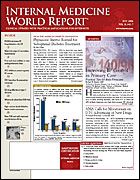Publication
Article
Internal Medicine World Report
Growth Factors Help Combat Neutropenia in the Elderly
Growth Factors Help Combat Neutropenia in the Elderly
ORLANDO—Febrile neutropenia, the bane of older patients receiving chemotherapy,
may be preventable, or at least greatly reduced, when growth factors are used in
the first cycle to stimulate the recovery of neutrophils in the bone marrow.
So says an initial report from a pioneering study of 701 elderly cancer patients that
was presented at the annual meeting of the American Society of Clinical Oncology.
“This is the largest prospective study focusing on chemotherapy side effects in
the elderly—of which febrile neutropenia is the worst, with its frequent hospitalizations,
heavy antibiotics use, and dose delays or reductions in potentially curative
chemotherapy,” notes coinvestigator Ludovico Balducci, MD, of the University
of South Florida College of Medicine, and head, Senior Oncology Program, H. Lee
MoffittCancer Center, Tampa. “Febrile neutropenia is the most common
presentation of infection in patients receiving chemotherapy,” he emphasizes.
Although most cancer diagnoses are made in those aged >65 years, randomized,
controlled studies involving this age-group are scarce, adds coinvestigator William B.
Ershler, MD, of the National Institute on Aging, and director, Institute for Advanced
Studies in Aging, Washington, DC. “Older patients are underrepresented in
clinical trials; they also are undertreated in the community due largely to fear of side
effects—notably febrile neutropenia, which can at times be fatal,” Dr Ershler
points out. “The paradox is, if you cut or delay the chemotherapy dosage, you
relieve side effects in the short-term but jeopardize cure in the long-term.”
Thus, this study documents the feasibility of conducting controlled clinical trials
in the community setting involving basically healthy older cancer patients receiving
chemotherapy. “It shows us that with growth factor support, their ability to benefit
from full-dose, on-time, myelosup pressive chemotherapy is as good as a youngerperson’s,” he said. This is a far cry from the view that age cutoffs are necessary in clinical trials. This
nationwide study was conducted by the Geriatric Oncology Consortium and included
701 patients with lung, breast, or ovarian cancer who were randomized to receive the
growth factor pegfilgrastim (Neulasta), starting either in the first chemotherapy cycle (n
= 349) or, at the physician’s discretion, in later cycles (n = 352).
A 60% decrease in the incidence of febrile neutropenia was seen across all
cycles in patients receiving pegfilgrastim starting in the first cycle compared with
those receiving it later. Regardless of which chemotherapy regimens
were used or type of tumor, all patients “showed a favorable outcome with
the primary prophylaxis,” Dr Ershler said. “The study also showed a 50% decrease in
chemotherapy dose reductions in patients receiving pegfilgrastim starting in cycle 1
compared with the others.” “‘Physician discretion’ can include waiting
until the patient has developed an alarmingly low white blood cell count,” he
told IMWR.
